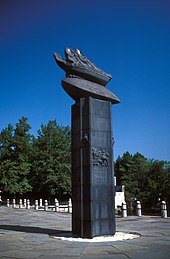Carl Milles
However, he remained in Paris, where he studied art, working in Auguste Rodin's studio and slowly gaining recognition as a sculptor.
In 1931, American publisher George Gough Booth brought Milles to Cranbrook Educational Community, in Bloomfield Hills, Michigan, to serve as his sculptor in residence.
[4] In 1938, for the 300th anniversary of the founding of New Sweden, the country commissioned a sculpture by Milles featuring a replica of the Kalmar Nyckel, the ship which originally brought the Swedish colonists to America.
Milles' fountain group The Wedding of the Waters in St. Louis symbolizes the Missouri and Mississippi Rivers merging just upstream.
Commissioned in 1936 and unveiled in May 1940 to a crowd of about 3000 people, the fountain caused a local uproar because of its playful, irreverent, naked, and nearly cartoonish figures, and because Milles had conceived the group as a wedding party.
Because Swedish law requires burial on sacred ground, it took the assistance of the then reigning Gustaf VI Adolf to allow this resting place.
Carl Milles expressed admiration for Nazi Germany and Adolf Hitler during the 1920s and 1930s, as well as for Benito Mussolini and Francisco Franco.
To Olga Milles, who remained in Graz for a while after the annexation (Anschluss) of Austria to the German Reich, Carl enthusiastically sent "Heil Hitler" greetings.







